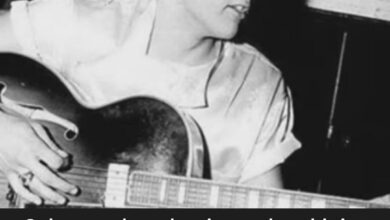Observe: Regardless of his state, his charisma remains intact
Elvis Presley, known as the “King of Rock and Roll,” is synonymous with the pioneering spirit of rock music and its cultural significance that emerged in the mid-20th century. His ability to meld various musical styles, including country, blues, and gospel, helped create a unique sound that resonated with millions across the globe. Born on January 8, 1935, in Tupelo, Mississippi, Presley’s rise to fame began in the 1950s, when his energetic performances and distinctive voice captured the attention of the nation. His charisma and magnetic stage presence established him not just as a musician but as a cultural icon.
The live performance of “Jailhouse Rock” in 1977, although late in his career, highlights how deeply embedded Presley was in the fabric of American music culture. By this time, he was experiencing significant challenges, including health issues and the pressures of fame, yet he managed to maintain a connection with his audience that few performers could achieve. In this performance, despite the wear of years, his ability to command the stage and engage the audience remained undisputed. His delivery of “Jailhouse Rock,” a song that tells the story of a man imprisoned and longing for freedom, resonates not only on the level of lyrics but also through the raw energy that Presley infused into every note.
Backed by a well-rehearsed band and enthusiastic backup singers, Elvis’s performance became more than just a musical production; it was a celebration of his legacy and the emotional connection he had forged with his fans over decades. He moved with a rhythm that seemed effortless, embodying the spirit of rock and roll itself. Even in the midst of personal turmoil, his voice remained a powerful instrument, capable of conveying both joy and heartache. This duality is a hallmark of his music and appeals to a wide audience, from young fans discovering him for the first time to older generations who grew up with his iconic sound.
The impact of “Jailhouse Rock” and its live performances are significant in understanding Elvis’s influence on subsequent musicians. The song, written by Jerry Leiber and Mike Stoller, became one of his early hits in 1957, and the accompanying film solidified his presence in the entertainment industry. The song’s infectious beat and catchy chorus make it a staple in rock music, inspiring countless covers and tributes. Its themes of confinement and yearning for freedom resonate with many, making it not just a mainstay of Elvis’s repertoire but a continuous point of reference in popular culture.
Elvis’s performances were a blend of showmanship and emotional genuineness. He established a connection that transcended mere entertainment; it was a dialogue with his audience. In his later performances, including “Jailhouse Rock,” this connection was evident, as fans were drawn to the sincerity in his delivery and the nostalgia he evoked. It’s remarkable how, even from a distance of years, his audience could feel a sense of togetherness, as if they were all partaking in the same shared experience.
Many artists today cite Elvis as an inspiration, drawing from his style, energy, and the way he engaged his audience. Modern rock and pop musicians often reflect the influence of his performances in their own stage presentations, recognizing the importance of charisma, stage presence, and the authentic expression of emotions in live music. Elvis’s approach to performance has set a standard that continues to be emulated by generations of artists. His blend of musical prowess and theatrical flair laid the groundwork for the concept of the modern rock concert.
Furthermore, the cultural implications of Elvis’s music, especially songs like “Jailhouse Rock,” cannot be overstated. As one of the first white performers to engage with the African American musical tradition in such a visible way, he played a role in breaking down racial barriers in the music industry, albeit within a complex socio-political context. His rise to fame opened doors for other artists across racial lines, contributing to a richer, more diverse music landscape.
As we reflect on his achievements, it’s essential to acknowledge the man behind the music. Elvis was a product of his environment—a Southern boy with humble beginnings—yet he evolved into a global icon. His struggles, particularly in his later years, remind us that even the most celebrated figures face challenges. It is a testament to his spirit that he continued to perform and connect with his audience until the very end of his life, demonstrating a relentless passion for music that remains inspiring.
Today, Elvis Presley’s legacy lives on through the countless artists who cite him as an influence, the continued popularity of his music, and the annual celebrations of his life and career. His performances, especially those like “Jailhouse Rock,” encapsulate the essence of rock and roll—a genre that is as much about feeling and connection as it is about sound. Elvis Presley’s live rendition in 1977 serves as a powerful reminder of his impact, illustrating not only his enduring popularity but also his indelible mark on music history.
In conclusion, Elvis’s “Jailhouse Rock” performance encompasses the larger narrative of his career—a journey filled with highs and lows, triumphs, and tribulations, all woven into the fabric of rock and roll. It is this tapestry of experiences that has ensured his status as an enduring cultural phenomenon, a testament to the power of music to transcend time and personal circumstance. Through the lens of his music and performances, Elvis Presley remains not just a king but a timeless legend whose influence will continue to resonate with future generations.



